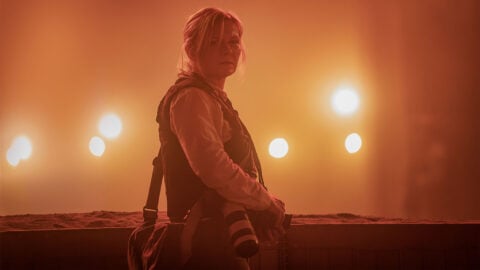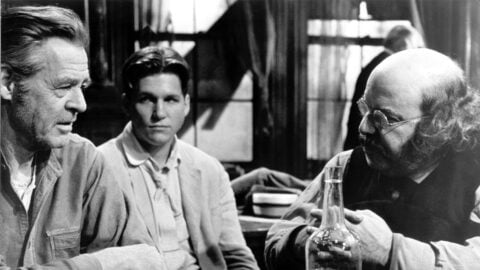Fassbinder Diary #2: In a Year of 13 Moons

Germany in Autumn
I was a sophomore in college when I saw In a Year of 13 Moons for the first time, and it was my introduction to Fassbinder. The year prior I had excitedly highlighted David Bordwell and Kristin Thompson’s half-exalting, half-exasperated descriptions of his work in Film History: An Introduction; out of anything in its “Young German Film” section, the still from Germany in Autumn in which Armin Meier leans against Fassbinder, eyes turned towards him cherub-like, as the director makes a phone call, remained burned in my mind for a long time afterward.
Coming to Fassbinder’s work cold, I had no idea how significant that particular image is in relation to In a Year of 13 Moons: Meier was the director’s lover for three years, and he committed suicide in the apartment they shared, after learning Fassbinder was going to end their relationship. Completed three months after Meier’s death, the 1978 film follows the anguished transsexual Elvira (Volker Spengler) during the four days leading up to her suicide; a few other biographical details from Meier’s life are also incorporated into Elvira’s character. Watching it again recently, I’m shocked by how much else I missed in addition to the personal history: references to Fellini, Godard, Jerry Lewis’s persona, composer Gustav Mahler’s life, and Fassbinder’s other films.
<img alt="In a Year of 13 Moons" src="http://www.filmlinc.com/page/-/vlcsnap-2012-06-27-21h07m59s60.png" style="width: 600px; height: 330px;" />
In a Year of 13 Moons
Fassbinder’s filmmaking—from the dialogue to the set design—is typically direct and profound. The narrative of In a Year of 13 Moons feels like a transposed torch song, something along the lines of Roy Orbison’s “Crying.” It opens on feet shuffling along a litter-strewn park trail, followed by the title “Frankfurt, July 24, 1978.” In the early morning light, it soon becomes apparent that the figures milling around are cruising, and as two of them wordlessly agree to have sex, more text appears explaining the significance of a year that has 13 full moons: there are more suicides, those who suffer from depression do so more intensely, etc. As soon as the text disappears, the encounter goes wrong, and Elvira—dressed as a man—gets a severe beating, crawling away with pants around her legs. Shortly after Elvira arrives home, her longtime, intermittently interested paramour Christoph turns up and begins gathering up his things.
According to him, their relationship was ruined by Elvira’s drinking (which has made her fat) and empty-headedness; in no condition to defend herself, she explains how lonely she is while stripping down to her underwear. Christoph isn’t the only person in the film who will tell her that she’s fat, ugly, and used up; it’s seemingly on the tip of everyone’s tongue. Like Fox in Fox and His Friends (75) or Emmi in Ali: Fear Eats the Soul (74), Elvira is inferior to her lover by society’s rules, and she’s internalized this hatred. Elvira couldn’t pass for a woman, and judging from her frame and height (accentuated by her penchant for high heels), it seems as if she never could. But as her exchange with Christoph makes immediately clear, there’s a feminine softness in the way she pronounces words, and a gentleness in her gestures and gait.
If Elvira’s a victim of her sex, unable to pass as a woman, she’s also a victim of love, and unable to exist independently. After unsuccessfully trying to stop Christoph from driving away in a taxi, her friend Red Zora (Ingrid Caven, a longtime collaborator and former wife of Fassbinder’s) scoops her off the pavement and buys her a coffee. Zora, who occasionally skips instead of walks, pairs a furry jacket with short, blonde hair like Fellini’s indefatigable Cabiria; her appearance is twice accompanied by the theme from Amarcord, evoking a sense of hope only to yield its opposite. (According to critic Charlie Fox, a later scene in which Zora watches TV while Elvira naps is a reference to Vivre sa vie, but unlike Anna Karina’s Nana, Zora doesn’t cry.) Elvira’s friend serves as her confidante, the conduit through which we are told her tortured past: Elvira used to be Erwin, an unwanted “Lebensborn child” who was raised by nuns. He apprenticed to a butcher, got married, and had a child. But he fell in love with Anton Saitz (Gottfried John), a Jewish criminal mastermind who “grew up in Bergen-Belsen” and tells Erwin that he’d love him if Erwin were a woman. When Erwin gets a sex change in Casablanca, Anton laughs at Erwin’s transformation into Elvira, and bereft of a job, family, or love, she attempts suicide, then dabbles in whoring, and eventually settles in with Christoph.

As Thomas Elsaesser has written, the core of the film is predicated on a series of “impossible” desires that go unfufilled: the impossibility of a straight man loving another man, of becoming someone’s object of love, of an Aryan loving a Jew; and finally, the assertion of identity that the immutability of the body denies. Rather than a Hollywood rom-com “dialectic” stumbling block to romantic coupling—he’s messy, she’s sophisticated!—or “the vicious circle of A loving B, but B loving C, and C only loving/hating himself” as in Sirk’s Written on the Wind or Ali: Fear Eats the Soul, this is one of Fassbinder’s most pessimistic statements on the possibility of love. Or connection of any kind: as Elsaesser also notes, the various groups of “outsiders” shown here—be they the gay men who beat up Elvira at the park, a group of Turks at an arcade, a North African man who hangs himself in an empty building—fail to find solidarity, and treat their fellow “outsiders” with incredulity or outright hostility. Instead of the ample cynicism about marriage and coupling shown in a myriad of his other films (from Why Does Herr R. Run Amok? to Martha to The Marriage of Maria Braun), In a Year of 13 Moons replaces it with a powerless feeling of barrenness.
The impossibility of love extends to loving oneself: like a Romantic protagonist of old, Erwin/Elvira had been born pure and reshaped by the world, but only on the outside. Alternating between sentimental fool (“What would life be without sentiment? Pretty sad, I'd say,” she murmurs) and slave to love from another, Elvira is perpetually undercut by her physical appearance, despite her best attempts: her bedroom mirror is tilted at a 45-degree angle, eliminating chance reflections; she wears hats with veils, one of which she pairs with a tight black dress (slimming!) when she finally dares to see Anton again after so many years. Her final spiral into darkness, marked by a haunting, chiaroscuro descent down a staircase, follows three rebuffed attempts to simply be with somebody, if only for a little while; her insecurity metastasizes into utter self-hate. It’s hard not to see that Fassbinder’s own self-loathing, enhanced by Meier’s suicide, at play here. Erwin/Elvira is therefore less rooted in Fassbinder’s own self-image or who Meier was and more a general composite of ill feeling and bad impulses.

A lingering question: how could anyone so softhearted truly fall in love with someone so ruthlessly devoted to capitalism as Anton? We finally see Anton, in what is the film’s only sort-of funny moment, one which comes right after Elvira has correctly given the ghoulish, all-access password “Bergen-Belsen” to Anton’s security guard. Anton, dressed in tennis whites, demands that his lackeys act out the “I Like to Hike” musical number from the 1955 Martin and Lewis film You're Never Too Young. This scene (and the act of performing it) begs comparisons to the mass gymnastic displays of the Hitler Youth, and the choreography and pageantry of Nazi ceremony. However, at its center is Anton, playing the Jerry Lewis character, a light-hearted, infantilized spastic. If underneath his character’s merciless Jewish stereotype exists this benign, cheerful persona, it makes sense why Erwin/Elvira is attracted to him. Perpetually physically uncomfortable and prone to second-guessing each sentence as soon as it has left her mouth, she sees past their superficial differences and finds a kindred, awkward spirit with his own mode of escape.
In a Year of 13 Moons is elegiac and complex, allowing a panoply of potential readings. (There’s probably even more to the Nazi references, for one thing, but that line of interpretation tends to straitjacket the film. Also, I’m not an expert, and I certainly don’t want to be.) If nothing else, it’s the most elegant release of grief transfigured into film, embodying its indiscriminate effects. This active grieving is most pronounced in the scene where Elvira and Zora visit a slaughterhouse (out of nostalgia for Elvira’s old profession), and Elvira is forced to shout her sweet remembrances of Christoph over the butchering. The single-tracking shot softens the blow of the twin aural and visual bombardment, the same sort of feeling that comes from seeing how Francis Bacon could so exquisitely render screaming mouths. The use of the Adagietto from Gustav Mahler’s “Fifth Symphony,” which plays under various scenes throughout the film, also provides a sweet counterpoint to the braying of German Christmas songs (which Elvira plays when she masturbates) or the shrieking in Suicide’s “Frankie Teardrop” (which plays while a gay man speaks about his time in a mental institution). The orchestral movement, which supposedly symbolizes the love Mahler felt for his wife, wordlessly imparts a tender sense of longing—again, Fassbinder’s earnestness, but made austere through music. Would that any of us were so lucky—or unlucky—to be loved by someone so talented so much.







